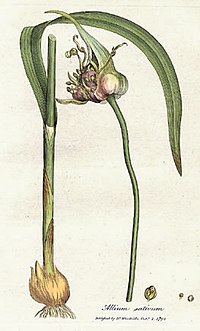
Photo from wikipedia
Chinese chives is a popular herb vegetable and medicine in Asian countries. Southwest China is one of the centers of origin, and the mountainous areas in this region are rich… Click to show full abstract
Chinese chives is a popular herb vegetable and medicine in Asian countries. Southwest China is one of the centers of origin, and the mountainous areas in this region are rich in wild germplasm. In this study, we collected four samples of germplasm from different altitudes: a land race of cultivated Chinese chives (Allium tuberosum), wide-leaf chives and extra-wide-leaf chives (Allium hookeri), and ovoid-leaf chives (Allium funckiaefolium). Leaf metabolites were detected and compared between A. tuberosum and A. hookeri. A total of 158 differentially accumulated metabolites (DAM) were identified by Gas Chromatography—Mass Spectrometry (GC-MS) and Liquid Chromatography—Mass Spectrometry (LC-MS), among which there was a wide range of garlic odor compounds, free amino acids, and sugars. A. hookeri contains a higher content of fructose, garlic odor compounds, and amino acids than A. tuberosum, which is supported by the higher expression level of biosynthetic genes revealed by transcriptome analysis. A. hookeri accumulates the same garlic odor compound precursors that A. tuberosum does (mainly methiin and alliin). We isolated full-length gene sequences of phytochelatin synthase (PCS), γ-glutamyltranspeptidases (GGT), flavin-containing monooxygenase (FMO), and alliinase (ALN). These sequences showed closer relations in phylogenetic analysis between A. hookeri and A. tuberosum (with sequence identities ranging from 86% to 90%) than with Allium cepa or Allium sativum (which had a lower sequence identity ranging from 76% to 88%). Among these assayed genes, ALN, the critical gene controlling the conversion of odorless precursors into odor compounds, was undetected in leaves, bulbs, and roots of A. tuberosum, which could account for its weaker garlic smell. Moreover, we identified a distinct FMO1 gene in extra-wide-leaf A. hookeri that is due to a CDS-deletion and frameshift mutation. These results above reveal the molecular and metabolomic basis of impressive strong odor in wild Chinese chives.
Journal Title: International Journal of Molecular Sciences
Year Published: 2022
Link to full text (if available)
Share on Social Media: Sign Up to like & get
recommendations!